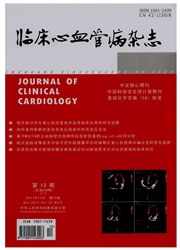

 中文摘要:
中文摘要:
目的:系统评价CHA2DS2-VASc评分在预防抗凝治疗房颤(atrial fibrillation,AF)患者脑卒中和(或)血栓栓塞(thromboembolism,TE)发生风险预测中的应用价值。方法:系统性检索Cochrane图书馆,PubMed和Embase等数据库,纳入国外已经公开发表的有关CHADS2和CHA2DS2-VASc评分预测脑卒中和(或)TE发生风险的相关队列研究。采用Revman 5.2软件进行Meta分析,计算合并后的相对危险度(risk ratios,RRs)和95%可信区间(confidence interval,CIs),分别比较在抗凝或未抗凝治疗AF患者CHA2DS2-VASc评分≥2(高危组)和CHA2DS2-VASc评分〈2(低中危组)分层内脑卒中和(或)TE风险发生情况。χ2趋势检验分析各危险组脑卒中和(或)TE发生风险与评分值的相关趋势。结果:本研究共纳入12篇文献,5篇以脑卒中为终点事件(RR=5.31,CI:3.69~7.62;P〈0.01),7篇以TE为终点事件(RR=5.94,CI:5.48~6.43;P〈0.01)(Pdiff=0.55);其中4篇研究对象接受抗凝基线治疗(RR=5.43,CI:4.92~6.00;P〈0.01),8篇研究对象未接受抗凝基线治疗(RR=5.92,CI:5.26~6.67;P〈0.01)(Pdiff=0.57)。CHA2DS2-VASc评分低危组终点事件发生率明显比CHADS2评分要低(0.54%vs 1.40%)(P〈0.05),且将更多的患者纳入高危组(81.0%vs 46.0%,P〈0.05)。结论:与CHADS2评分相比,CHA2DS2-VASc评分将更多的AF患者归类于高危组,且高危组脑卒中和(或)TE发生风险更高,并显示已接受抗凝治疗的AF患者仍然存在脑卒中和(或)TE发生风险,且随风险评分系统分值的增高而显著升高。这提示AF卒中预防性抗凝药物治疗需要正确评估而规范化实施。
 英文摘要:
英文摘要:
Objective:To perform a systematic review and meta-analysis of the predictive abilities of CHA2DS2-VASc in stroke and systemic thromboembolism(TE)risk stratification of atrial fibrilltion(AF)patients with and without anticoagulation therapy.Method:The data were systematically retrieved by searching the Cochrane Library,PubMed and Embase databases to identify relevant cohort studies published in English reporting the diagnostic performance between CHADS2 and CHA2DS2-VASc.Review Manager 5.2software were used to perform the statistical analyses.The risk ratios(RRs)with the 95% CI were presented and pooled for comparative analysis of the occurrence of TE and/or stroke between CHA2DS2-VASc2and CHA2DS2-VASc≥2,also considering the presence or absence of anticoagulation therapy.Result:Twelve cohort studies were identified in the analysis.Of these included studies,7of the included studies reported TE outcomes,and 5studies included a record of stroke events.With regard to the occurrence of outcomes individually,patients with CHA2DS2-VASc scores≥2showed a greater risk for stroke(RR5.31,CI:3.69~7.62;P〈0.01)and TE(RR5.94,CI:5.48~6.43;P〈0.01)(Pdiff=0.55),regardless of the presence or absence of anticoagulation therapy(RR5.43,CI:4.92~6.00;P〈0.01 and RR5.92,CI:5.26~6.67;P〈0.01,respectively)(Pdiff=0.57).The average ratio of endpoint events in the lowrisk group of CHA2DS2-VASc was less than CHADS2(0.54% vs 1.40%,P〈0.05).The average proportion of the high-risk group of CHA2DS2-VASc was greater than CHADS2(81.0% vs 46.0%,P〈0.05).Conclusion:Our results showed better diagnostic performance for CHA2DS2-VASc over CHADS2 for the distribution of greater numbers of patients and a greater incidence of endpoints events into the high-risk stratification,as well as the identification of patients with atrial fibrillation who are at substantial risk of endpoint events with or without optimal anticoagulant therapy.It indicates that the prophylactic anticoagulation treatment of
 同期刊论文项目
同期刊论文项目
 同项目期刊论文
同项目期刊论文
 期刊信息
期刊信息
